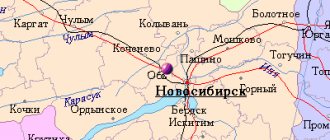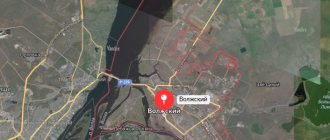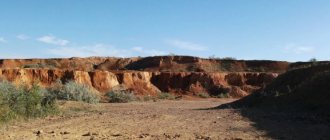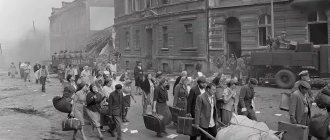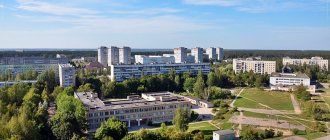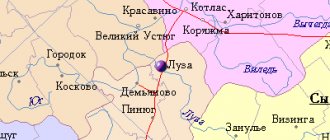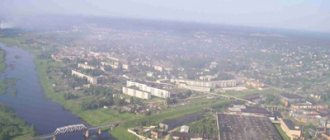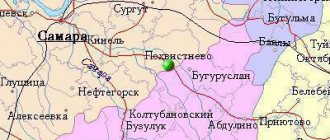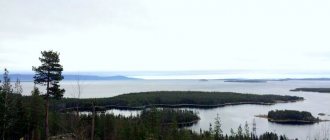Farms that gave the foundation to the city of Novotroitsk
Hello again, dear readers! Today we will talk to you about several settlements that once existed on the site of modern Novotroitsk.
Of course, many people know that the city of Novotroitsk arose from the village of Novo-Troitskoye, on a site near which the construction of OKMK began.
Altov and other well-known researchers of the history of Novotroitsk write that in addition to Novo-Troitsk, on the site of the modern city there was also the village of Silnov with several courtyards; this also includes Akkermanovka, Khabarnoye, Staro-Ackermanovka, and Novonikolskoye, as well as crossing point 213 km, Guberlyu station, Prigornoye village, Kryk-Pshak, Novorudny village. But all these settlements except Silnov and Novo-Troitsky became part of the city much later.
It should also be remembered that on the square of modern Novotroitsk there are tracts - disappeared settlements, such as the Berezhnaya Vtoroy farmstead, the Babak brothers' farmstead, as well as the Svyato-Troitsky farmstead (aka Dudnikov). I have already written about Berezhnaya Vtoroy and the Babak brothers’ farm; you can read the material by following the link.
Now I will try to describe to you how all this actually happened and tell you a little about Silnov and Holy Trinity.
If we take the map of the Orsk district of the Orenburg province in 1922, then on it we will, naturally, not see either modern Novotroitsk or Akkermanovka in the place where it is located now.
The map shows the Akkermanovsky farm (aka Ivanovsky), the Vostok agricultural artel, the Svyato-Troitsky farm (aka Dudnikov), Berezhnoy Vtoroy, the Babak brothers farm and others. Of course, the Khabarny detachment of the Orenburg Cossack army and the Razboika farmstead in the area of the Topkogo stream are indicated here.
But the village of Novo-Troitskoye does not exist, because it appeared a little later.
The village of Novo-Troitskoye was already mentioned in the lists of populated places in the Orenburg province in 1926. That is, in 1922 it was not yet there, but in 1926 it already was.
And where, you say, is Silnov?
And the village of Silnov is not indicated here. But he was. And it is one of the farms on the site of which Novotroitsk was built.
And what the “Vostok” agricultural artel is is generally unclear. But, of course, reference books come to the rescue and explain everything.
In the list of populated places of the Orenburg province in 1926, as part of the Orsky district of the Orsk volost, a settlement is indicated in the Khabarnensky village council
-commune “Vostok” at number 56.
There is only one courtyard in the commune, the predominant population is Tatars, 27 people live in the commune. The name of the commune was given by the population of eastern origin accordingly. But what follows is quite interesting. Under number 60 in the same directory, the village of Silnova is indicated, opposite which it is written that you need to look at number 56. That is, it turns out that the Vostok commune and the village of Silnova are the same settlement. Vostok is its modern name, and Silnov is its former name.
In one of the works on local history, written by my son, the Silnova farm was already mentioned. Together with him, we went to the Novotroitsk museum and exhibition complex, where we were shown its location next to the Novotroitsk cement plant.
In light of recent events and the identification of the Vostok commune and the Silnov farm, I was able to link the coordinates of the old map of 1922 and modern ones, as a result of which it turned out that the Silnov farm was located on the territory of modern Ural Steel.
But reading the memoirs of Alexei Dudnik’s grandson Alexander Pometun, it turned out that the Silnov farm was located in the area of the chemical plant workshops.
You can find out the history of the origin of the name by clicking on the link that contains the work.
Analyzing map data, people's memories, data from reference books on the territorial division of the Orenburg province, I came to the following.
At the beginning of the 20th century, in the place where the chemical plant workshops are now located (as Pometun recalls) (or 2.5 km to the south, as I determined), there was once a small farm of several courtyards that belonged to Silnov, a native of the Cossacks.
In 1901, the farm had 2 courtyards, it was located near Lake Udobnoe, and 6 people lived in it.
But why such different data on the location of the farm? Museum workers unanimously say that this is near the Cement Plant. And earlier in the work this location was written about. And the monument to Podzorov (an armored car) stands in place near the Tsemzavod. The work was written based on the memories of museum workers. Now I am ready to challenge this fact. The map gives me a place near the cooling towers of Ural Steel; Dudnik’s grandson remembers the workshops of the chemical plant. I believe that the determination of the location of Silnov near the Tsemzavod is incorrect; most likely, the museum workers were guided by the fact that near the Tsemzavod there is a monument to the armored car of the sailor Podzorov, in which he died fighting the Cossacks in the area of the Silnova farm. But Podzorov died in the place where now there is a monument with a flying seagull when leaving Orsk towards Novotroitsk, opposite the cross-monument to the fallen Cossacks during the Civil War. That is, it seemed logical to put an armored car there. But the Podzorovites died in the area of the Silnova farmstead, and not near it. Therefore, the Silnova farm could not be located where the monument now stands. It was located, this farm, some 7 km from the place of death. What else was there to take as a guide during the Civil War? Khabarnoye is quite far away, Orsk is approximately 18 km from the place of death. Nearby are the farms of Silnova, Svyato-Troitsky, the Babak brothers, Berezhnoy Vtoroy, Akkermansky, and somewhere very far away are the farms of Razboiny, Beloshapochny. We took the Silnova farmstead as a landmark for the place of death. With the same success, the Svyato-Troitsky farm could have remained in history; it was also not far away. But Silnov remained in my memory. Pometun’s memoirs also include circumstances in which his grandfather Alexei Dudnik (a resident of Svyato-Troitsky) saved one of the wounded Podzorovites. And then he was confused with Silnov (whose farm was nearby) and brought to Orsk for trial. But the rescued Podzorovite recognized his savior Dudnik and insisted that it was definitely not Silnov, but “the dedicated comrade Dudnik.”
LiveInternetLiveInternet
There are a lot of photos in the topic.
Until I was 6 years old, I lived with my mother in Koltubank, in our homeland. My parents’ family broke up a long time ago, although the divorce was not officially filed.
In 1957, my mother met our fellow countryman Ivan Yakovlevich Petukhov. Before that, he lived for ten years in a civil marriage with a woman who considered him her legal husband. They had no children. Perhaps Ivan Yakovlevich wanted to have a child in his new family - he loved his nephews very much. But the first wife was not going to calmly give in to his rival. A quiet family life in Koltubank did not threaten them. There was only one way out - to leave.
Uncle Lesha and Aunt Zina Karkhanin—my mother’s sister’s family—have left their homeland two years ago and settled in Novotroitsk. They called mom there.
The three of us left Koltubanka for Novotroitsk in the summer of 1957.
Novotroitsk was a young, growing city, clean, green, with a developed, as it is now called, infrastructure, where the city-forming enterprise was OKhMK, the Orsko-Khalilovsky Metallurgical Plant (since 1992, Ural Steel OJSC).
At first we lived with our relatives on Pushkin Street, in a house opposite the Luch cinema.
Novotroitsk. November 7, 1957. In the courtyard of house No. 23 on Pushkin Street.
Of course, I didn’t remember the house number. I found my bearings using today’s map of the city: opposite the house there was a cinema “Luch”, Pushkina, 28.
Unfortunately, I don’t remember anyone from my neighbors. Maybe one of the old residents will recognize themselves and others. Then write to me on Odnoklassniki - Lyudmila Elfimova (Demchenko). In the photo I'm on the far right in the first row.
Mom got a job as a pediatrician and received from the city health department one room in a two-room apartment at the address: st. Sovetskaya, 9, apt. 42. It was a large three-story house of “Stalinist” construction, with wide flights of stairs, on the central street of the city, along which a tram runs. There is a train station across the road.
Gradually they acquired furniture typical of that time: a sofa with a high wooden back, a bamboo Chinese bookcase, nickel-plated metal beds with knobs on the backs. Mom knew how to create coziness: artificial flowers in tall flower beds, embossed starchy white curtains, napkins, table runners, valances. The shelves of the bookcase were decorated with the inevitable “lucky” elephants, little boxes, and figurines. Mom loved to embroider, her cross stitches decorated the walls of her Novotroitsk apartment, I still keep them.
I remember our family life in Novotroitsk as calm and serene.
Novotroitsk. Sovetskaya street, 9/42. January 7, 1959.
I remember the renovation in our house. Nowadays such repairs are called cosmetic. It was summer, housing office workers were whitewashing, painting, and repairing plumbing in the apartments. The residents of nine apartments in our entrance were moved to the attic along with their furniture so as not to be disturbed. A “commune” was formed under the roof: the common space was divided into rooms with blankets and sheets. Food was prepared right there on primus stoves and kerosene gases. In the evenings the laughter did not stop for a long time. It appeared in one or the other end of the attic, and was unanimously taken up by the entire community. Sometimes the jokes were not for children's ears, but we were small and did not understand anything.
My childhood friend Farida Suleymanova promised to send me photographs of this period that she kept.
Novotroitsk. Sovetskaya street, 9, Suleymanovs’ apartment.
The neighbors all lived together. Here, guests from Baku came to the Suleymanovs - the parents of Farida’s mother. On this occasion, relatives and neighbors, mothers – mine and Sveta Shilo’s – gathered together.
The Shilo family, natives of the Kirovograd region, sometimes received parcels with apples from their relatives from Ukraine - they were sure to treat their neighbors.
In the backyard of our house, the most thrifty of the residents built two or three rows of sheds. Shilo kept two wild boars there. “The Little Russian cannot live without lard,” the neighbors joked at them. Behind the sheds there was a rather steep slope towards a river, which was called a “lake”. In winter, the slope served as a slide for the children, and the lake as a skating rink. On the other side there were vegetable gardens. There was a path along the lake; if you followed it to the right, you could reach large oak trees and collect acorns. This entire area was a haven for children.
In the photo from 1959, behind my friend Sveta Shilo, is part of the landscape described above.
My mother worked as a local pediatrician in a city hospital, part-time in a nursery, my stepfather was apparently a foreman at a school for physical education, I remember a photograph of him with a group of students.
Novotroitsk. January 1960 Children's nursery No. 5 on Sovetskaya street.
On Sundays, the park became the center of city life, where concerts were held on an open stage. Famous artists were invited to the professional holiday - Metallurgists' Day. I remember the pop star of that time, Nina Dorda, and the popular songs she performed - “Lilies of the Valley”, “Geologists”, “Trains”.
There was also a dance floor in the park. The police and vigilantes especially closely monitored order there. The fact is that after the opening, decent, socially approved dances were danced, and towards the end, as soon as the vigilance of law enforcement officers weakened or they were distracted by other areas, the local dudes tried to stir up rock and roll, which was then prohibited. This was an offense for which they were taken to the police.
Parents had to rescue their unlucky children. Among the dudes was my cousin Yura Galeev. He wore a headdress a la Elvis Presley. He was short and agile - he was used to perform the most spectacular rock and roll stunts involving throwing him over his head. His mother, my Aunt Zina, a party member and head of the city health department, often had to contact the police authorities because of Yurik. Novotroitsk rock and rollers also went on “tours” to other cities, at the invitation of friends or relatives, to show themselves. Yurik recalled such a trip, it seems, to Kurgan.
Football matches were held at the Metallurg stadium, located next to the park. In winter, they played bandy there, and there was a constant skating rink with skate rentals.
With the onset of frost, a slide was poured on the square in front of the park and an ice town was built. The ice figures were illuminated, the garlands on the New Year's tree and throughout the square shimmered - movement, fun, atmosphere and mood of the holiday.
Representatives of the then-friendly China trained at OHMK; there were about sixty of them. We were brought up as internationalists. When meeting a Chinese person on the street, it was customary to greet him in Chinese, which I did too. On May 1 and November 7, after the demonstration, the Chinese staged a performance in national costumes on the square in front of the hotel, with the obligatory dragon dance. This spectacle attracted many people. With the beginning of the Cultural Revolution in 1961 and the deterioration of relations between the two countries, the Chinese were recalled to their homeland, but several of them managed to get married and remained in Novotroitsk.
I remember a story that my grandmother told me with humor from the words of good friends of the Karkhains. They were friends with the Chinese. Then in Novotroitsk there were a lot of good goods from the Middle Kingdom. Their friend came to visit them for a holiday. Seeing the hostess wearing Chinese black suede sandals with gold edging, very beautiful, and clicking his tongue approvingly, he expressed his admiration: “Only a prostitute wears such shoes!”
After the break in relations with China, Soviet people wore Chinese gabardine suits and coats for a long time - blue and beige, artificial fur coats, shoes that were not demolished. For many years, families used Chinese tablecloths, bedspreads, terry towels, thermoses with hieroglyphs, bright flowers, birds of paradise, parrots, and dragons. We had such things too.
1958 My relatives, the Karkhanis, are in Kislovodsk. Aunt Zina and Uncle Lyosha are dressed in Chinese gabardine.
On holidays and on the occasion of the arrival of guests, feasts were held at our house.
December 1958. Sovetskaya, 9/42. Aunt Zina and Uncle Lyosha Karkhanin, grandmother, stepfather, mother.
The same feast, but in the photo there are guests from Koltubanka - stepfather’s brother Fyodor Yakovlevich and his wife. True, as it turned out in a conversation with Ivan Yakovlevich’s recently found niece, Valentina Fedorovna Gavrish, the young, round-faced man is not a relative.
The same participants in the feast and two young women whom I don’t remember.
Parents themselves often went in company. These two photographs remain as a keepsake; in my opinion, they well convey the relaxed, friendly atmosphere.
On the back there is only the date: 1958.
December 5, 1958. Western village. Apartment of Makarov A.V.
Who all these people are and what role they played in the life of my mother and stepfather, I may no longer recognize.
In the summer we went to the Urals in a truck that was at Uncle Lyosha’s disposal. Before my eyes there is a picture of fishing with nonsense. Sunny day, fast current, sun glare on the water blinds the eyes. We settled down on a gently sloping sandy shore; the opposite shore was high, rocky, with caves in the steep cliffs. The water in the Urals is cold and springy even on the hottest days. The drag is large, almost the width of the river. His stepfather and uncle Lyosha pulled him, each on his own side. Frozen, they pulled him out with fish, which they cleaned themselves. Women cooked fish soup in a pot over a fire. The audience, quite hungry, could not wait for her. We returned at night; jerboas danced on the road in the headlights.
The climate in those places is harsh, sharply continental - in summer the heat is up to 40 degrees, in winter the frost is down to -50. Sometimes a blizzard raged in the city for several days, it was so dark that the street lights were turned on during the day. The tram tracks were instantly covered with snow, and snowplows were constantly working. For some reason I loved walking down the street in this weather. I still love watching the movement of snowflakes in the light of lanterns.
This is how we would have lived in Novotroitsk, but it was cramped in one room. Massive housing construction began a little later, and my parents understood that there was no prospect of improvement in our living conditions in the near future. Mom, like all health workers, subscribed to the Medical Newspaper. Each issue was full of announcements with standard content: “Required... (then medical specialties were listed). Housing space is provided... (the terms were indicated - upon arrival, within a month, six months, a year...). Part-time work is possible (this meant the opportunity to work not for a full-time salary, but for a quarter- or one-and-a-half-time salary, which was very important).”
The people at that time were easy-going. Mom wrote to several addresses, received replies, and in the end there were two options left: the city of Uzlovaya, Tula region, 30 km from Tula, and the city of Kohtla-Jarve, then in the Estonian SSR. Uzlovaya provided housing every month, and Kohtla-Jarve, it seems, every six months. This decided the matter in favor of Uzlova. We picked up a container from the railway station, loaded our things - and off we went!
Series of messages “Pedigree of the Elfimovs”:
Part 1 - Elfimov Anatoly Matveevich. To the 70th anniversary of the Victory. Let's remember everyone by name... Part 2 - Genealogy of the Elfimovs. The story of my relationship with my father's family. ... Part 8 - Personalities of the Elfimov family. Elfimov Boris Matveevich, my uncle, my dad's younger brother. Part 9 - About me and my roots. Part 10 - My family's life. Novotroitsk, Orenburg region. 1957-1960 Part 11 - My childhood from 6 to 9 years old. Novotroitsk, Orenburg region. 1957-1960 Part 12 - My childhood from 0 to 6. Koltubanka, Buzuluksky district of the Chkalov (now Orenburg) region. 1951-1957 Part 13 - Trip to Kaluga in April 2015. Part 14 - Personalities of the Elfimov family. Tatyana Ivanovna Elfimova (1899-1987).
